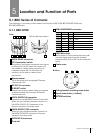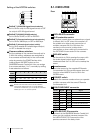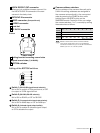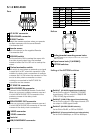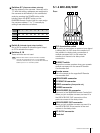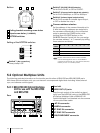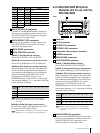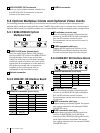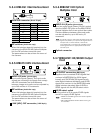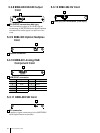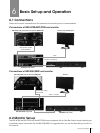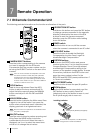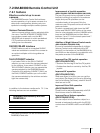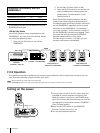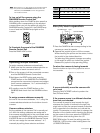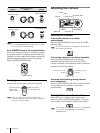
21
Location and Function of Parts
AUDIO L/R jacks (phono-type)
Input audio signals (stereo). The input audio
signals are converted into signals that comply
with HDV standards. The time difference
between image and audio can be adjusted by
up to 240 minutes in 10 increments.
DIP switches (inside the cap)
When this interface board is inserted into the
camera or the BRU-H700 HD Optical Multiplex
Unit, the DIP switches cannot be used.
The parameters can be set from the menu of
the camera.
i.LINK (HDV) OUT connector (i.LINK 6-pin)
5.3.4
HFBK-XG1 XGA Interface Board
1 2
5.3.5
HFBK-TS1 HDV Interface Board
1
1 2 3
2
3
1
MONITOR connector (D-sub 15-pin)
2
DIP switches (inside the cap)
When this interface board is inserted into the
camera or the BRU-H700 HD Optical Multiplex
Unit, the DIP switches cannot be used.
The parameters can be set from the menu of
the camera.
Pin No. Signal Pin No. Signal
1 R (X) 9 NC
2 G (X) 10 GND
3 B (X) 11 NC
4 NC 12 NC
5 GND 13 HD
6 R (G) 14 VD
7 G (G) 15 NC
8 B (G)
5.3.7 BRBK-HSD1 HD/SD-SDI Output
Card
1
SDI OUTPUT connectors (BNC-type)
Supplies down-converted SD-SDI signals that
conform to SMPTE259M (for 59.94i signal
format) and ITU-R BT.656 (50i signal format)
serial digital interface standards, and HD-SDI
signals that conform to the SMPTE292M serial
digital interface standard. Select HD-SDI or
SD-SDI signals with the HD/SD select switch.
HD/SD select switch
Set the switch to SD to supply SD-SDI signals
and HD to supply HD-SDI signals.
SDI OUTPUT
BRBK-HSD1
SD HD
1 2
• SD-SDI and HD-SDI signals cannot be supplied
simultaneously.
• Set the SD/HD select switch before turning on
the camera.
Note
2
5.3.6
BRBK-MF1 HD Optical
Multiplex Card
1
AUDIO IN L/R jacks (phono-type)
Input an audio signal (stereo), which is output
from the AUDIO OUT jacks on the BRU-H700 HD
Optical Multiplex Unit via an optical fiber cable.
The time difference between video and audio
can be adjusted by up to 240 ms by 10
ncrements.
Optical connector
2
1 2
The audio input on this board accepts audio line
signals only. When you input audio signals from a
microphone or similar device, it should be
connected with a microphone amplifier so that
audio signals with an appropriate audio level
can be input.
Note



